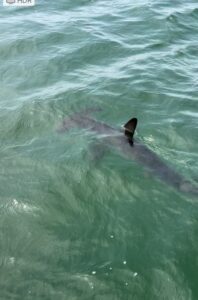
Side scan image of the wreck of the Pendleton off Cape Cod
PROVINCETOWN – A research team from the Center for Coastal Studies in Provincetown is releasing new underwater images this week from the wreck of the Pendleton.
It comes just days before “The Finest Hours,” a movie based on the rescue mission and sinking of the tanker, is released in theaters nationwide.
The Pendleton was heading from New Orleans to Boston when it broke in two during a gale in February 1952 off Cape Cod.
A four-man crew aboard the Coast Guard Motor Lifeboat 36500 dispatched from Chatham in what is known as the greatest small boat rescue in the history of the U.S. Coast Guard.
The heroics of the crew saved 32 of the 41 men aboard the tanker.
Dr. Mark Borelli, Center for Coastal Studies Director of Marine Geology, conducted a high resolution survey of the wreck last month using a state-of-the-art side scan scanner.
Borelli and technician Ted Lucas collected images showing a clear illustration of the devastation the sea has brought to the remains of the boat.
“The boat really snapped in half. Part of it got hauled away, and there’s just not much left of it. It’s almost unrecognizable as a boat, and I think it speaks to the amount of energy that was in that storm and was required to rip that boat apart,” said Borelli.
The bow section of the Pendleton grounded on Pollack Rip Shoal. It was sold in 1953 to North American Smelting Company for recycling at Bordentown, New Jersey, but was stranded in the Delware River and dismantled there in 1978 by the U.S. Army Corp of Engineers.
 The stem of the ship eventually grounded off Monomoy Island, south of Chatham, where it remained visible until the late 1980’s.
The stem of the ship eventually grounded off Monomoy Island, south of Chatham, where it remained visible until the late 1980’s.
According to Borelli, fragments of the ship are scattered over an area approximately 250 feet by 100 feet. The seafloor can be seen encroaching on the wreckage. Little of the structure is identifiable, with the exception of some of the massive beams.
“It’s in 30 feet of water, it’s relatively close to land, so there is going to be some wave action. It is going to be moved around during storms and things like that,” Borreli said.
The Center for Coastal Studies said the distinctive pattern may help archaeologists and historians determine the original location of that section of the tanker.
Borelli said his new images will be shared with the U.S. Coast Guard and the Massachusetts Board of Underwater Archaeology. In recent years, his crew has conducted several seafloor mapping projects on the Outer Cape. They’ve also surveyed local harbors to locate, identify and retrieve derelict fishing gear and other marine debris.
The Disney movie being released this week was co-written by Casey Sherman, a native of Barnstable.
By MATT PITTA, CapeCod.com News Director

























Speak Your Mind